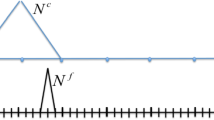Abstract
The Lagrangian block hydrodynamics is formulated based on the block advection of fluid. By enforcing the mass and momentum conservations on the Lagrangian mesh, the numerical oscillation problem encountered in the classical Eulerian computational methods is circumvented. A large number of the previously computationally difficult problems in environmental fluid mechanics are successfully simulated using the method. Examples of these simulations are described in this paper.
Similar content being viewed by others
References
Chu V H, Altai W. Simulation of shallow transverse shear flow by generalized second moment method. J Hydraul Res, 2001, 39(6): 575–582.
Chu V H, Altai W. Simulation of turbulence and gravity interfaces by Lagrangian block method. Computational Fluid Dynamics 2002, New York: Springer-Verlag, 2002, 299–304.
Tan L W, Chu V H. Simulation of wave fronts on dry beds using Lagrangian blocks. Engrg Comput Mech, 2009a, 162(EM2): 57–66.
Tan L W, Chu V H. Lauber and Hager’s dam-break wave data for numerical model validation. J Hydraul Res, 2009b, 47(4): 524–528.
Tan L W, Chu V H. Wave runup simulations using Lagrangian blocks on Eulerian mesh. J Hydro-environ Res, 2010a, 3(4): 193–200.
Tan L W, Chu V H. Wet-and-dry interface on steep slopes simulations using Lagrangian blocks. Proc 6th Int Symp Env Hydraul, 2010b, Athens, Greece.
Tan L W, Chu V H. Dam-break flood simulations using 2D Lagrangian blocks on Eulerian mesh method. Proc 6th Int Symp Env Hydraul, 2010c, Athens, Greece.
Harlow F H. The particle-in-cell computing method for fluid dynamics. Methods Comput Phys, New York: Academic Press, 1964, 3: 319–343.
Monaghan J J. Smoothed particle hydrodynamics. Reports Progress Phys, 2005, 68(8): 1703–1759.
Ritter A. The propagation of water waves. Zeitschrift des Vereines Deutsher Ingenieure, 1892, 36(33): 947–954.
Stoker J J. Water Waves: The Mathematical Theory with Applications. Wiley Interscience, 1957.
Hogg A J. Lock-release gravity currents and dam-break flows. J Fluid Mech, 2006, 569(1): 61–87.
Ancey C, Iverson R M, Rentschler M, et al. An exact solution for ideal dam-break floods on steep slopes. Water Resources Res, 2008, 44: W01430.
Shen M C, Meyer R E. Climb of a bore on a beach: part 3, run-up. J Fluid Mech, 1963, 16(1): 113–125.
Peregrine D H, Williams S M. Swash overtopping a truncated plane beach. J Fluid Mech, 2001, 440: 391–399.
van Leer B. Towards the ultimate conservative difference scheme, II, Monotonicity and conservation combined in a second-order scheme. J Comput Phys, 1974, 14: 361–370.
Gaskell P H, Lau A K C. Curvature compensated convective transport: SMART, a new boundedness preserving transport algorithm. Int. J Num Meth in Fluids, 1988, 8: 617–641.
Leonard B P, Mokhtari S. Beyond first-order upwinding: the ULTRA-SHARP alternative for non-oscillatory steady-state simulation of convection. Int J Num Meth in Fluids, 1990, 30: 729–766.
Leonard B P, Drummond J E. Why you should not use ‘HYBRID’, ‘POWER-LAW’ or related exponential schemes for convective modelling — there are much better alternatives. Int J Num Meth in Fluids, 1995, 20: 421–442.
Pinilla C E, Bouhairie S, Tan L-W, et al. Minimal intervention to simulations of shallow-water equations. J Hydro-env Res, 2010, 3(4): 201–207.
Celik I B, Ghia U, Roache P J, et al. Procedure for estimation and reporting of uncertainty due to discretization in CFD applications. J Fluids Engrg, 2008, 130: 1–4.
Thacker C W. Some exact solutions to the nonlinear shallow-water wave equations. J Fluid Mech, 1981, 107: 499–508.
Webb R H, Schmidt J C, Marzolf G R, et al. The controlled flood in Grand Canyon. American Geophy. Union, 1999, Monograph 110.
Pinilla C, Chu V H. Waves and bed-friction effect on stability of transverse shear flow in shallow waters. J Coastal Res, 2008, 52: 207–214.
Pinilla C, Chu V H. The role of wave radiation on instability of coastal current. Proc. 33rd Congress IAHR, 2009a, Vancouver, Canada.
Pinilla C, Chu V H. Wave radiation and shear instability in rotating stratified flow. Proc 28th Int Conf on Ocean, Offshore and Arctic Engrg, 2009b, Honolulu, Hawaii.
Author information
Authors and Affiliations
Corresponding author
Rights and permissions
About this article
Cite this article
Tan, Lw., Chu, V.H. Lagrangian block hydrodynamics for environmental fluid mechanics simulations. J Hydrodyn 22 (Suppl 1), 627–632 (2010). https://doi.org/10.1016/S1001-6058(10)60009-1
Published:
Issue Date:
DOI: https://doi.org/10.1016/S1001-6058(10)60009-1




